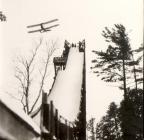28
These were arguably the heyday years for jumping competition in the Ottawa region. By 1935, a decline in the number of young people joining the sport was threatening its viability. Compounding the problem was a worrying decline in the number of spectators attending events in Rockcliffe Park. Maintaining the tower had become a burden in terms of the amount of labour required for its upkeep and its drain on the Club's financial resources.30
Sigurd Lockeberg, whose involvement with the OSC went back to its formation, had already anticipated the decline of the sport and in 1933 begun work on a new ski jump at Camp Fortune. At the same time, a new organization, the Norland Ski Club undertook the work necessary to ensure that the Fairy Lake jump continued to function. With the completion of the new Camp Fortune facility, known as the Lockeberg Jump, the tower in Rockcliffe Park was dismantled in 1937.32
After a 5-year hiatus, during which time the competition was held at better facilities in Montreal, Three Rivers, and a new jump in Banff, the Dominion Championships finally returned to the Ottawa region in 1938. Most of the Norland Ski Club's jumping group, quietly deserted the Fairy Lake facility for the taller, more challenging Lockeberg tower. Norland's tower, now abandoned and neglected, went into decline.33
Jumper mid jump off Lockeberg Ski Jump, Camp Fortune, Gatineau Hills, QC 73.2.1.21945
Gatineau Hills, Old Chelsea, QC

34
Herbert Marshall shaking hands with Viscount Alexander of Tunis at Camp Fortune on Feb. 2, 1952.1952
Gatineau Hills, Old Chelsea, QC

35
The Lockeberg Jump in 1938 was far from being a "perfect structure". Minor improvements were made in the years following but a major reconstruction had to wait until 1947. This final phase, opened on 29th of February 1948 by the Governor General of the time, Viscount Alexander of Tunis, resulted in one of the finest jumping hills in Eastern Canada from which jumps of up to 189 feet were achieved.36
Judges stand, Lockeberg Jump at Camp Fortune, Old Chelsea, QC 85.22.1.301953
Gatineau Hills, Old Chelsea, QC

37
Lockeberg Jump Hill; Slalom Hill tow and Slalom Hill; and Camp Fortune in 1953.1953
Gatineau Hills, Old Chelsea, QC

38
In 1953, in a effort to attract more newcomers to a sport again in decline, a smaller tower, 25 feet in height suitable for practice and training, was proposed for Rockcliffe Park. Tentative approval was received from the Federal District Commission which leased the park from its owner, the City of Ottawa. Unfortunately, the City and Commission were unable to approve an arrangement to charge both users of the hill and spectators at competitions thus removing the only sources of revenue for the maintenance of the jump. The tower was dismantled after a single year of operation. An era had come to an end. There would be no further jumping in Rockcliffe Park.39
Lockeberg Ski Jump, Camp Fortune, Gatineau Hills, QC 1953 x2003.14.011953
Gatineau Hills, Old Chelsea, QC

40
However, the need for better training facilities remained. Three yearslater, in 1956, an intermediate jump hill (a "B" jump) was constructed at
Camp Fortune. This was followed by a junior jump in 1960 together with even smaller jumps for a midget program. The OSC was fortunate to have an energetic Jumping Committee driving these developments, Paul and Jacques Berniques, Raymond Desrochers, Maurice Landry, Fred Morris, Raymond Pare, Jean Yves Richer, with Franz Baier leading the group. Franz Baier also introduced a weekly meeting of ski jumpers to discuss techniques, style and practise gymnastic exercises adapted to ski jumping training. These new initiatives would have far-reaching effects.


